 |
 |
 |
| |
Review Activity/Safety: Telaprevir in Combination with Peginterferon Alfa-2a and Ribavirin Increased Sustained Virologic Response in Genotype 1 Chronic HCV
|
| |
| |
Reported by Jules Levin
HEP DART 2011, Koloa, Hawaii, USA, December 4-8, 2011
RS Kauffman*1, AJ Muir2, DR Nelson3, P Andreone4, GT Everson5, GM Dusheiko6, S Pol7, N Adda1, CI Wright1, L Bengtsson1, M Martin1, AJ Sankoh1, S George1, IM Jacobson8, KE Sherman9, S Zeuzem10
1Vertex Pharmaceuticals Incorporated, Cambridge, MA, United States; 2Duke Clinical Research Institute, Durham, NC, United States; 3University of Florida, Gainesville, FL, United States; 4UniversitÓ di Bologna, Bologna, Italy; 5University of Colorado Denver, Aurora, CO, United States; 6Royal Free and University College, London, United Kingdom;7UniversitÚ Paris Descartes, Paris, France; 8Weill Cornell Medical College, New York, NY, United States; 9University of Cincinnati College of Medicine, Cincinnati, OH, United States; 10Johann Wolfgang Goethe University Medical Center, Frankfurt am Main, Germany.
CONCLUSIONS
Telaprevir-based treatment significantly improved rates of SVR compared to PR alone in treatment-naïve and treatment-experienced patients with chronic genotype 1 HCV infection, including those with poor prognostic factors, such as:
- Black/African American patients
- Patients with bridging fibrosis or cirrhosis
- Patients with high baseline viral load
In treatment-naïve patients:
- Approximately two-thirds of patients were eligible for 24 weeks of treatment.
- 24 weeks of total treatment was not inferior to 48 weeks of total treatment among patients who achieved eRVR.
In treatment-experienced patients:
- There was no apparent benefit to a 4-week PR lead-in with telaprevir.
- SVR rates achieved by prior relapsers were high (86%) and similar to cure rates achieved by treatment-naïve patients (79%).
- Prior null responders achieved a 6-fold improvement in SVR versus PR alone (32% vs 5%).
The safety profile of telaprevir was well-characterized. Patients who received telaprevir combination treatment reported a higher incidence of rash, anemia, gastrointestinal symptoms, and anorectal adverse events than patients who received PR alone. Rash and anemia were manageable and reversible.
In patients with cirrhosis, there was a higher incidence of anemia and thrombopenia in patients who received telaprevir combination treatment than in patients who received PR alone.
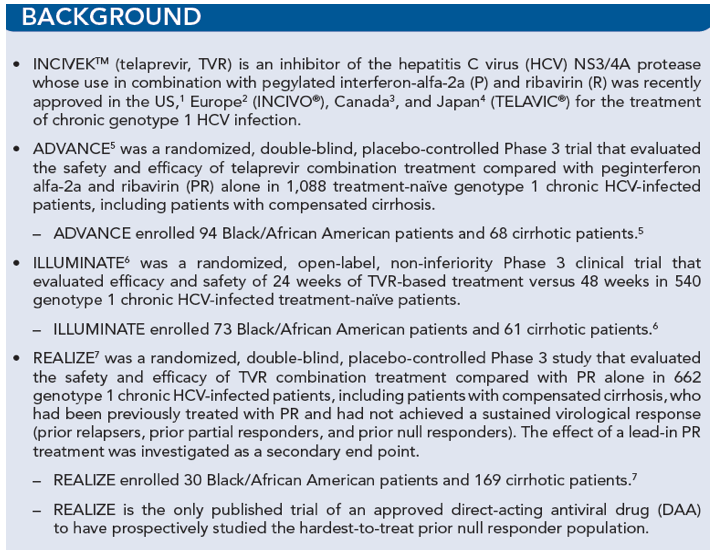
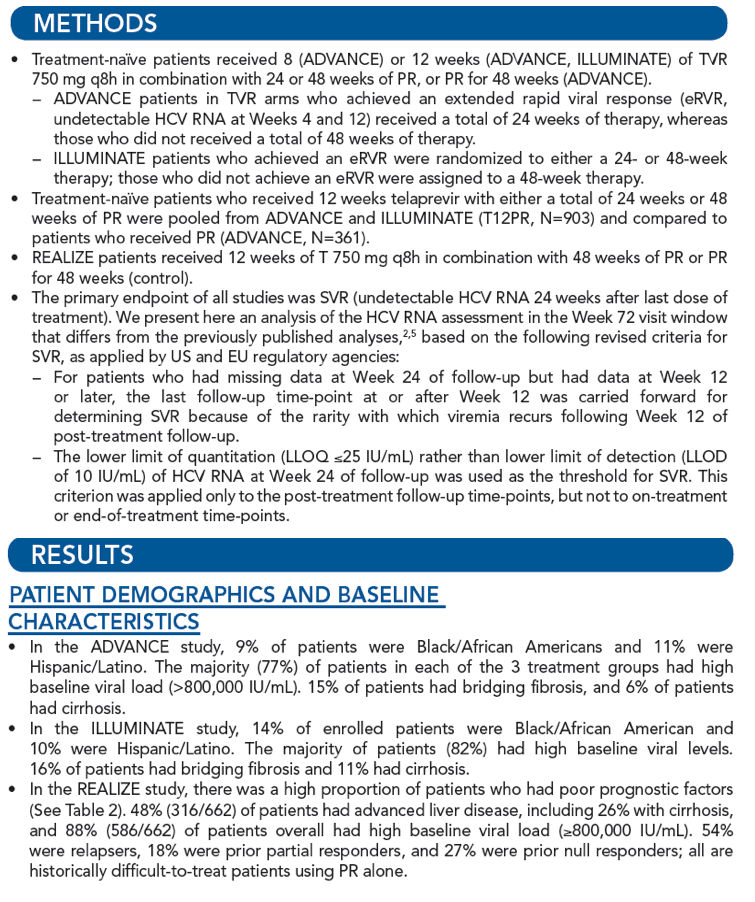
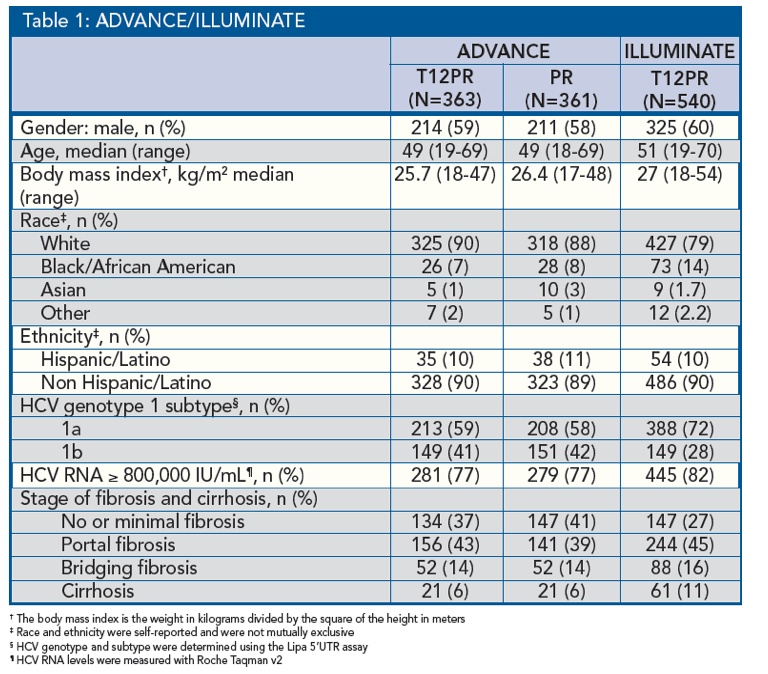
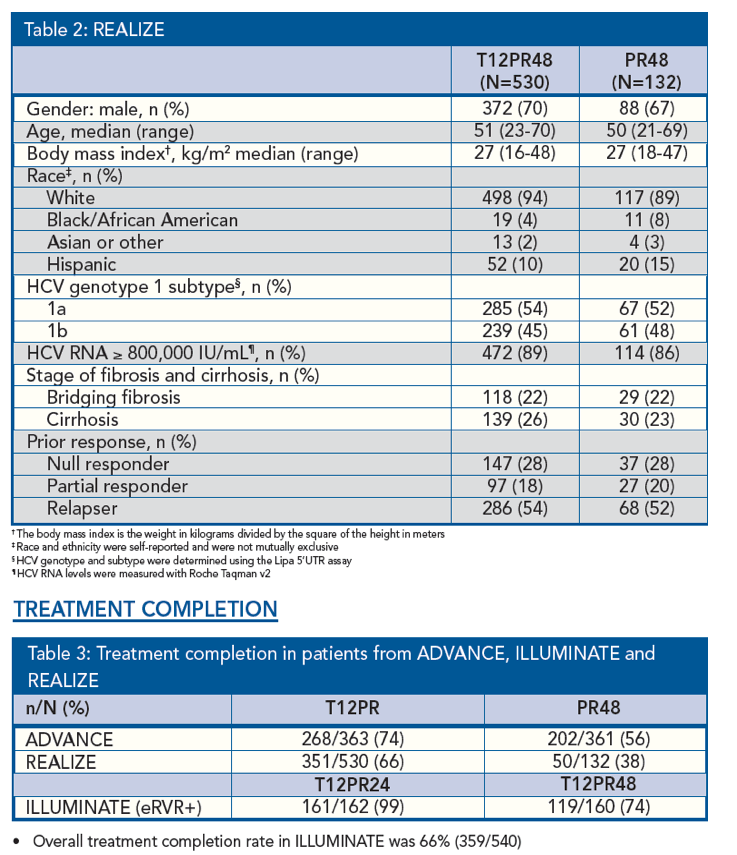
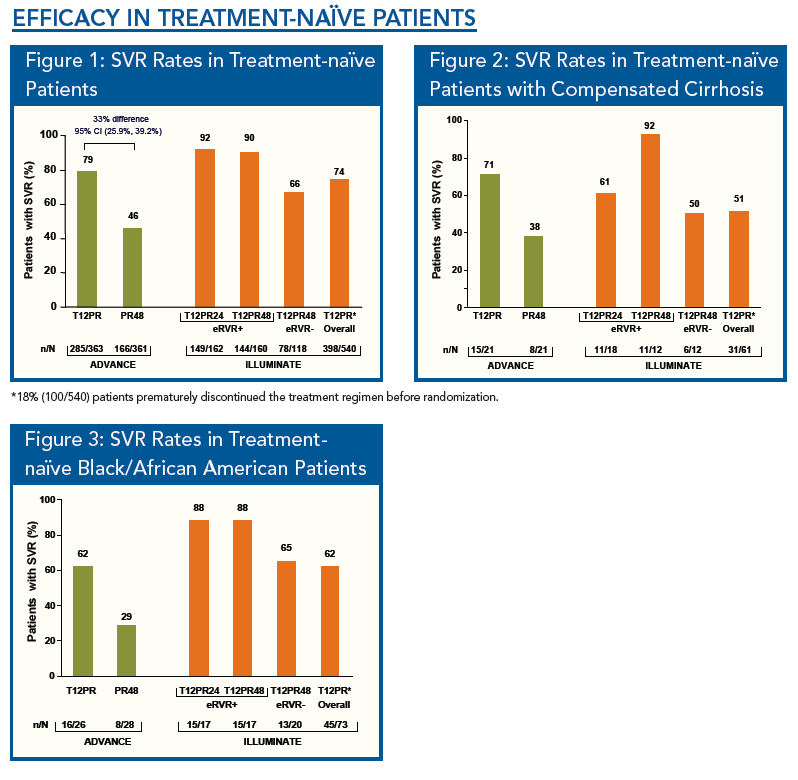
The proportions of treatment-naïve patients with eRVR in
ADVANCE were 58% (212/363) in the T12PR group versus 8% (29/361) in the PR48 group,
and 65% (352/540) in ILLUMINATE.
In the ADVANCE study, 71% of T12PR patients with cirrhosis achieved SVR,
as compared with 38% treated with PR alone (Figure 2).
SVR rates were 92% and 61%, respectively, among eRVR+ patients with cirrhosis in the T12PR48 and
T12PR24 arms of ILLUMINATE (Figure 2). Although the patient numbers were low, these results
suggest that patients with cirrhosis could benefit from 48 weeks of PR treatment.
Relapse rates in ADVANCE were 11/298 (4%) and 53/220 (24%) in T12PR and PR48, respectively.
Relapse rates in ILLUMINATE were 16/423 (4%) for overall T12PR and 6/87 (7%) for eRVR- patients.
Relapse rates in patients with eRVR who were randomized to T12PR24 and T12PR48 were 9/159 (6%)
and 1/149 (1%), respectively.
EFFICACY IN TREATMENT-EXPERIENCED PATIENTS
SVR rates among those treated with telaprevir-based regimens were similar between the
lead-in and no lead-in arms of the study, and hence the results were pooled, as shown in Figure 4.
Prior relapsers to PR therapy achieved high SVR rates (86%), similar to the cure rate achieved by
treatment-naïve patients (ADVANCE/ILLUMINATE).
Null responders, the hardest-to-treat category of non-responders to prior PR therapy,
achieved a six-fold improvement in SVR versus PR (32% versus 5%).
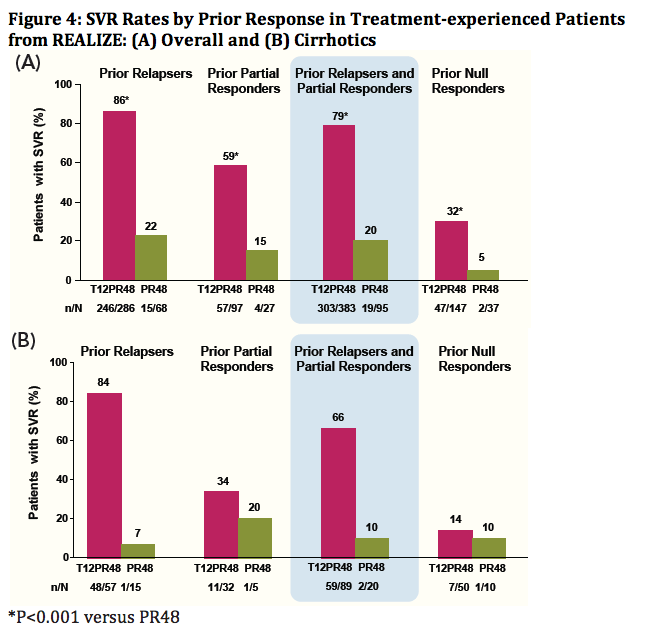
Relapse rates in REALIZE for T12PR48 and PR48, respectively were:
- Prior relapsers: 8/254 (3%), 27/43 (63%)
- Prior partial responders: 14/71 (20%), 0/4 (0%)
- Prior null responders: 15/62 (24%), 2/4 (50%)
- Four percent (19/530) of treatment-experienced patients who received telaprevir-based treatment
were Black/African Americans; the SVR rate for these patients was 63% (12/19) compared to
65% (328/498) for Caucasians.1
- Twenty-six percent of REALIZE patients who received telaprevir-based treatment had cirrhosis at baseline.
SVR rates among cirrhotic patients who received telaprevir-based treatment compared to PR48 were:
87% (48/55) compared to 13% (2/15) for prior relapsers, 34% (11/32) compared to 20% (1/5) for prior
partial responders, and 14% (7/50) compared to 10% (1/10) for prior null responders.1
- IL-28B genetic polymorphisms are a key predictor of the response to PR in HCV patients.
Because IL-28B was discovered after patient enrollment in REALIZE, patients were not randomly
assigned to this marker. However, in a retrospective analysis of REALIZE, the highest proportion of
IL-28B TT patients was among prior non responders (28%), whereas the highest frequency of CC patients
occurred among prior relapsers (27%).8 IL-28B genoČtype did not contribute to outcome prediction
in prior treatment-experienced patients treated with a telaprevir-based regimen and thus, may be of limited
utility in this setting.8
OVERALL SAFETY
Across the three Phase 3 studies, a total of 1, 797 patients were randomized to any
T/PR combination regimen, and 493 to placebo/PR regimen (Table 4)
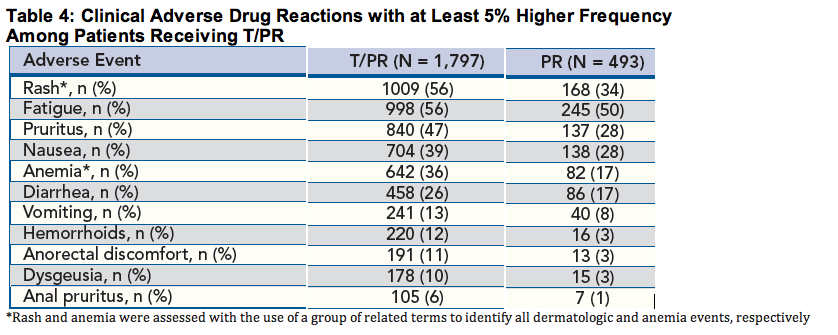
Telaprevir's safety profile is similar across treatment-naive and treatment-experienced patients.
14% of patients discontinued telaprevir due to adverse drug reactions. Rash, anemia, fatigue, pruritus, nausea, and vomiting were the most frequent adverse drug reactions leading to discontinuation of telaprevir. The incidence of rash was 56% (including 4% severe rash) in the T/PR group, and 34% (including <1% severe rash) in the PR group during the overall treatment phase; the incidence of anemia was 36% in the T/PR group and 17% in PR.1
Rash and anemia led to discontinuation of telaprevir combination treatment in 1% of patients.1
- If rash progressed and became severe, TVR was discontinued while PR was continued.1
- Anemia was managed by ribavirin dose reduction according to the ribavirin prescribing information.9
Discontinuation of telaprevir-based treatments due to anorectal signs and symptoms occurred in <1% of patients who received TPR. All events resolved during or after completion of TVR dosing.1
SAFETY IN CIRRHOTIC PATIENTS
Across the three Phase 3 studies, safety data was available for 221 (T12PR) and 51 (PR) patients with cirrhosis (F4)
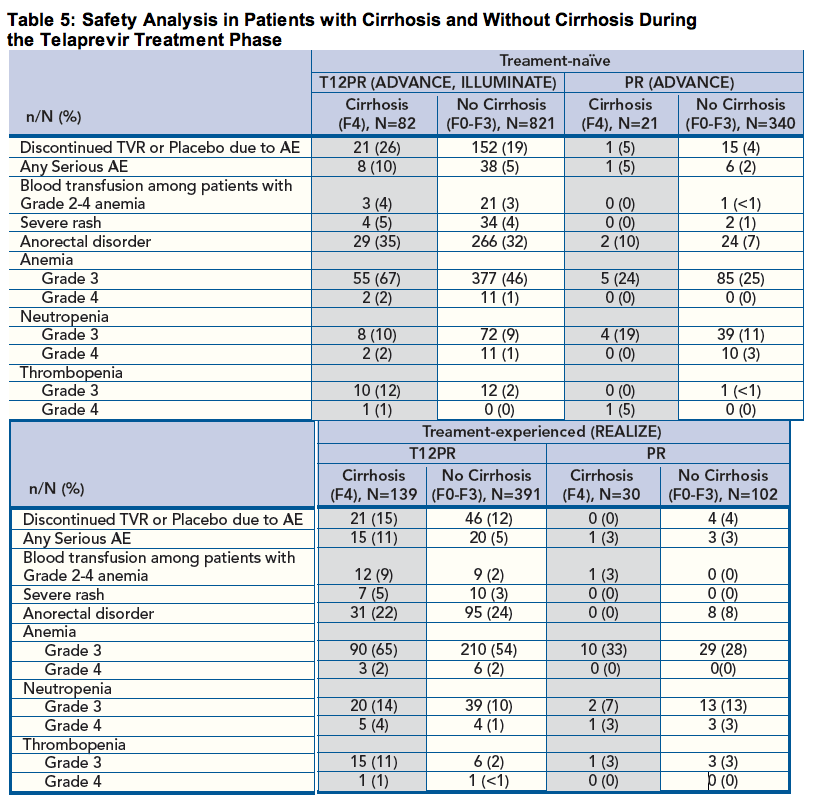
References
1. INCIVEK™ [package insert]. Cambridge, MA: Vertex Pharmaceuticals Incorporated; 2011.
2. INCIVO® [EU Summary of Product Characteristics]. Beerse, Belgium: Tibotec BVBA; 2011.
3. INCIVEK™ [Canada Product Monograph]. Laval, Quebec, Canada: Vertex Pharmaceuticals Incorporated; 2011.
4. TELAVIC® [Press release]. Osaka, Japan: Mitsubishi Tanabe Pharma; 2011.
5. Jacobson IM et al. N Engl J Med 2011;364:2405-16.
6. Sherman KE et al. N Engl J Med 2011;365:1014-24 [Erratum: N Engl J Med 2011;365:1551].
7. Zeuzem S et al. N Engl J Med 2011;364:2417-28.
8. Pol S et al. J Hepatol 2011;54:Suppl. 1. S6-S7.
9. Copegus [Package insert]. South San Francisco, CA: Roche-Genentech; 2011
|
| |
|
 |
 |
|
|